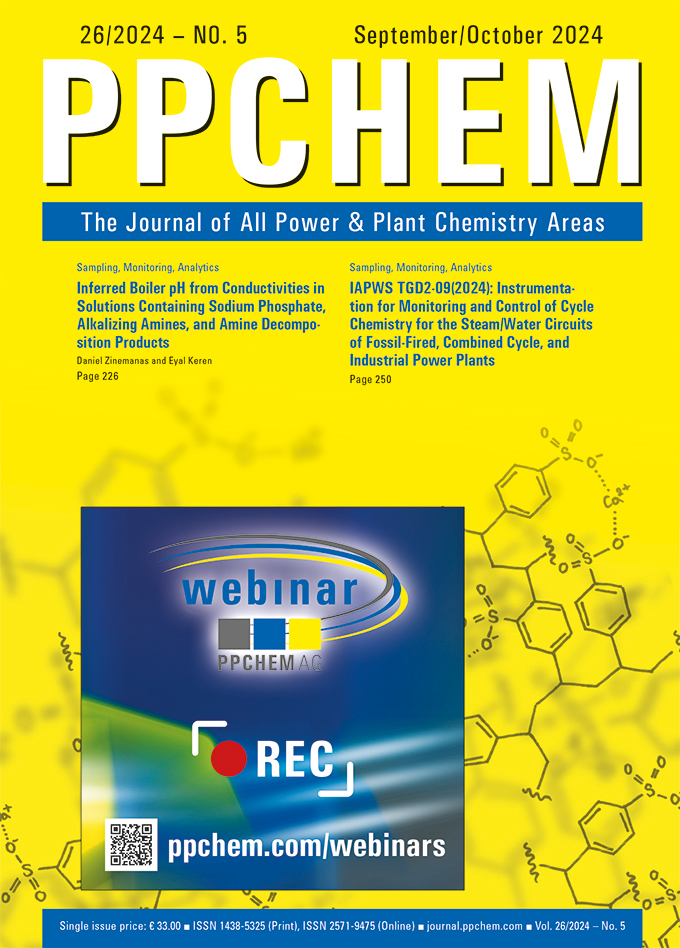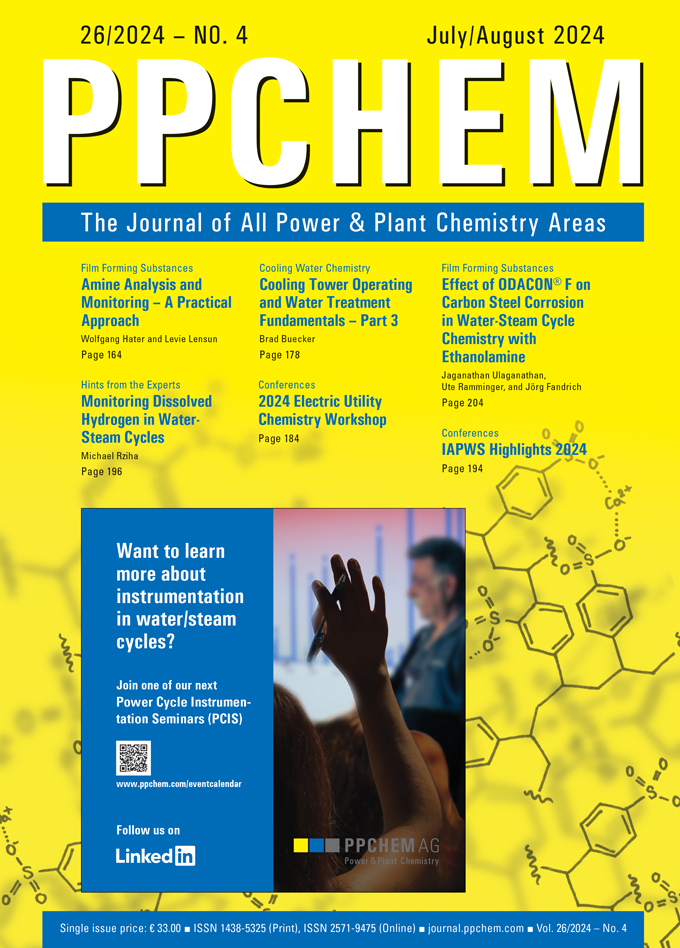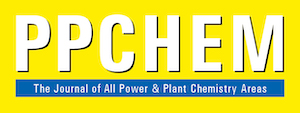Author: anderthalbAdmin
Article – Issue 06 (2024) – Water Treatment of Flue Gas Condensate – White Paper
Article – Issue 06 (2024) – Supplemental Oxygen for All-Volatile Treatment under Oxidizing Conditions
Issue 05 (2024)

For members only
ABSTRACTS
Tribute to Prof. Wolfgang Wagner
The German-Swiss Association for the Properties of Water and Steam e.V.
This issue includes a tribute to a highly respected member of the International Association for the Properties of Water and Steam (IAPWS) community who recently passed away. Professor Wolfgang Wagner’s dedication, warmth, and significant contributions have left a lasting legacy within our field. He was a pioneer in improving data correlation techniques for the thermodynamic properties of water and steam. Under his leadership, IAPWS developed the current international formulations for the thermodynamic properties of water and steam. His presence will be deeply missed, and we honor him for his invaluable impact on our community. This tribute is from the joint national committee of Germany and Switzerland, of which he was an honorary member.
PPCHEM® 2024, 26(5), 224–225
Inferred Boiler pH from Conductivities in Solutions Containing Sodium Phosphate, Alkalizing Amines, and Amine Decomposition Products
Daniel Zinemanas and Eyal Keren
Accurate knowledge of the pH in boiler water is an important and central chemical parameter for the monitoring and control of the boiler chemical conditions and is critical to minimizing the corrosion processes. pH measurements, however, are not always easily or accurately measured, so alternative means of correctly estimating the boiler pH can be useful for achieving these goals. In certain situations, the conditions are even quite complex and challenging since the impurities which negatively affect the chemical parameters arise from the treatment chemicals themselves, such as, for example, the products of the thermal decomposition of organic alkalizing amines used for pH control. Thus, it is the purpose of the present study to show an alternative way by means of the calculation of the inferred pH from the specific conductivity and the conductivity after cation exchange and to describe its application, together with these conductivities, to the monitoring and control of the boiler water in relatively complex solutions in which sodium phosphates, alkalizing amines, and amine decomposition products are present. The methodology described in the paper is applied in a cogeneration plant with a dual pressure heat recovery steam generator equipped with an air-cooled condenser, where, as demonstrated, very good results were achieved. The study also emphasizes the main concerns and disadvantages regarding the use of organic alkalizing amines in water/steam cycle water treatment.
PPCHEM® 2024, 26(5), 226–237
For Members only
IAPWS TGD2-09(2024): Instrumentation for Monitoring and Control of Cycle Chemistry for the Steam/Water Circuits of Fossil-Fired, Combined Cycle, and Industrial Power Plants
The International Association for the Properties of Water and Steam
This Technical Guidance Document was first issued in 2009 and revised in 2012 and 2015. This 2024 revision includes a small number of updates and clarifications. These do not constitute significant changes to the scope of the document or to the guidance contained.
In order to achieve suitable chemical conditions in steam/water circuits, it is essential to establish reliable monitoring of key parameters on every plant. This enables the demonstration of operation within cycle chemistry targets, and alerts the operators to the need to take corrective action when the target conditions are compromised.
This technical guidance document considers conventional fossil, combined cycle / HRSG, and industrial plants and identifies the key instrumentation and monitoring techniques required for each plant type and cycle chemistry treatment. It is emphasized that this is an IAPWS guidance document and that, depending on local requirements, the use of simpler instrumentation may be adequate, whereas more complex techniques and instrumentation may be necessary when specific issues arise.
PPCHEM® 2024, 26(5), 250–275
E-Paper – Issue 05 (2024)
Article – Issue 05 (2024) – IAPWS TGD2-09(2024): Instrumentation for Monitoring and Control of Cycle Chemistry for the Steam/Water Circuits of Fossil- Fired, Combined Cycle, and Industrial Power Plants
Download the Article’s PDF.
Article – Issue 05 (2024) – Inferred Boiler pH from Conductivities in Solutions Containing Sodium Phosphate, Alkalizing Amines, and Amine Decomposition Products
Article – Issue 05 (2024) – Tribute to Prof. Wolfgang Wagner
Download the Article’s PDF.
E-Paper – Issue 04 (2024)
Issue 04 (2024)

For members only
ABSTRACTS
Amine Analysis and Monitoring – A Practical Approach
Wolfgang Hater and Levie Lensun
Amines are used for three different purposes in a water/steam cycle (WSC): as reducing agents (reducing amines (RA)), to adjust the pH in the WSC (alkalising amines (AA)), and to protect the inner surfaces of the WSC by the formation of an adsorptive film on the metal surfaces (film forming amines (FFA)). Monitoring and control have to be chosen according to the purpose of use. The chemistry and selected properties that are important for the application and control of the amine groups are presented.
This article discusses the different approaches for monitoring and control of the three groups of amines together with the common methods of analysis. For the monitoring of RA and AA, standardised methods of analysis are available. exchange.
For FFA monitoring, two main methods are available, which are primarily applied for grab samples. They are well established; however, there is a limit of detection so that in some cases free residual FFA cannot be detected in the whole WSC, and, thus, the completeness of film formation is not proven.
A process for the upgrading of FFA to improve the limit of detection is proposed which is suitable for on-site application. Furthermore, several approaches for indirect analysis of FFA in water are presented in which test specimens are introduced into the WSC. Either the FFA adsorbed on the surface is measured or, alternatively, the FFA presence is proven via the change in surface properties due to the effect of FFA adsorption. In this way the completeness of film formation in the WSC can be demonstrated.
PPCHEM® 2024, 26(4), 164–173
For Members only
Cooling Tower Operating and Water Treatment Fundamentals – Part 3
Brad Buecker
Cooling water systems are an integral component of many power plants and thousands of industrial facilities. The previous installment focused on microbiological fouling, as this phenomenon often causes the most prompt and severe difficulties in cooling systems. However, scale formation and corrosion (including corrosion caused by microbiological deposits) can also be very problematic if not properly monitored and controlled. Treatment programs for both are often interlinked, so this and the next installment highlight the most common corrosion and scaling mechanisms, followed by Part 5, which will examine modern corrosion/scale control chemistry.
PPCHEM® 2024, 26(4), 178–183
For Members only
2024 Electric Utility Chemistry Workshop – Highlights and Press Release
The 2024 Electric Utility Chemistry Workshop again offered a broad range of important topics for steam generation chemists, engineers, and managers. This article offers several highlights from the event. A somewhat overlooked benefit of this conference is its potential value for those employed at co-generation and large industrial plants, where water and steam treatment issues are similar and equally as important as for the power industry. Accordingly, the planning committee is renaming the event the Electric Utility and Co- Generation Chemistry Workshop (EUC2W) to emphasize the workshop’s value to diverse industrial personnel.
PPCHEM® 2024, 26(4), 184–187
IAPWS Highlights 2024 – 18th International Conference on the Properties of Water and Steam (ICPWS) & Annual Executive Committee and Working Group Meetings
Continuing a series of conferences started in 1929, the 18th International Conference on the Properties of Water and Steam (ICPWS) was held in Boulder, Colorado, on June 23– 28, 2024. The Conference is organized by the International Association for the Properties of Water and Steam (IAPWS) and for the first time was combined with another conference: the 22nd Symposium on Thermophysical Properties (STP). The STP is held in the U.S. every three years and brings together experts in the theory, modeling, and measurement of thermophysical properties of fluids and solids. The joint meeting allowed a wider community of researchers to be exposed to the work of IAPWS and gave people from IAPWS the opportunity to learn about leading-edge research and applications in fields outside water and steam. The combined conference attracted 440+ attendees from 29 countries.
PPCHEM® 2024, 26(4), 194–195
Monitoring Dissolved Hydrogen in Water-Steam Cycles
Michael Rziha
The idea of using the measurement of dissolved hydrogen to assess the formation of protective coatings is nothing new. As early as 1953 (!), H. Kiekenberg published an article in the German “VGB Mitteilungen” on hydrogen measurements in Benson and drum boilers, followed by further publications by other well-known authors in the following years. Corrosion occurs in the presence of water or steam in contact with iron at high temperatures. According to the Schikorr reaction, hydrogen is released as a by-product during the formation of a protective layer in a power plant. Hydrogen monitoring thus becomes important in corrosion monitoring for water-steam cycles; the hydrogen concentration is a very sensitive indicator of corrosion.
PPCHEM® 2024, 26(4), 196–199
For Members only
Effect of ODACON® F on Carbon Steel Corrosion in Water-Steam Cycle Chemistry with Ethanolamine
Jaganathan Ulaganathan, Ute Ramminger, and Jörg Fandrich
Film-forming amine (FFA) applications are a recent strategy used by nuclear power plants for the corrosion protection of secondary-side components during outages and normal operation. Laboratory investigations of FFA applications are usually conducted in static autoclaves under conditions that are different from the field, where the conditions are dynamic with factors such as temperature and single-/two-phase flow varying throughout the water-steam cycle. To address this gap, the H3 Loop, a recirculating loop at Canadian Nuclear Laboratories was used to investigate the effect of ODACON® F, a commercial FFA, on the corrosion of pre-oxidized (PO) carbon steel (CS) tubing exposed to ethanolamine chemistry under two-phase flow conditions at 180 °C and 15 % steam quality. Post-test weight measurements showed negligible corrosion due to the preexisting oxides. Water beading tests and scanning electron microscopy examination demonstrated that the PO CS surfaces exposed to ODACON® F under different temperatures and single-/two-phase flow conditions were hydrophobic due to film formation and not the pre-existing oxides.
PPCHEM® 2024, 26(4), 204–215

